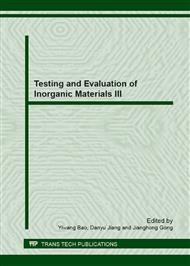[1]
Nitin P. Padture. In situ-toughened silicon carbide. J. Am. Ceram. Soc. 77 (1994) 519-23.
Google Scholar
[2]
Casady J. B, Jchnson R.W. Status of silicon carbide(SiC)as a wide-bandgap semiconductor for high-temperature a-pplications: A review . Solid-State Electron. 39 (1996) 1409-1422.
DOI: 10.1016/0038-1101(96)00045-7
Google Scholar
[3]
Xiong Y., Fu Z. Research Development of TiB2-based Metal Ceramics. Bull. Chin. Ceram. Soc. 1 (2005) 60-63.
Google Scholar
[4]
Mastral .F., Thevenot F. Ceramic composites: TiB2-TiC-SiC part I properties and micostructure in the ternary system. J. material science. 26 (1991) 5547-5560.
DOI: 10.1007/bf02403957
Google Scholar
[5]
Weasche R. Klaffke D. In situ formation of tribological effective oxide interfaces in SiC-based ceramics during dry oscillating sliding . Tribology letters. 5 (1998) 173-190.
Google Scholar
[6]
Blanc C. and Thevenot F. Wear resistance of SiC-TiB2 composites prepared by reactive sintering. J. Eur. Ceram. Soc. 19 (1999) 571-579.
DOI: 10.1016/s0955-2219(98)00250-7
Google Scholar
[7]
Zhang G., Jin.Z., Yue.X. Effect of Ni addition on mechanical properties of TiB2/SiC composites prepared by reactive hot pressing. J. material science. 32 (1997) 2093-(2097).
Google Scholar
[8]
Wang W., Fu Z., Wang H., and Yuan R., Influence of hot press sintering temperature and time on microstructure and mechanical properties on of TiB2 ceramic. J. of Eur. Soc. 22 (2002) 1045-1049.
DOI: 10.1016/s0955-2219(01)00424-1
Google Scholar
[9]
Basu B., Raju G.B. and Suri A.K., Processing and properties of monolithic TiB2-based materials. Int. Mat. Rev., 51 (2006) 352-374.
Google Scholar
[10]
Omori M, Takei H. Preparation of pressureless sintering of SiC–Y2O3–Al2O3. J Mater Sci. 23 (1988) 3744-3747.
DOI: 10.1007/bf00540522
Google Scholar
[11]
V. V. Pujar, R.P. Jensen, N.P. Padtrue. Densification of liquid-phase-sintered silicon carbide. J. Materials Science Letters. 19 (2000) 1011-1014.
Google Scholar
[12]
G. Rixecker, I. Wiedmenn, A. Rosinus, et al. High-temperature effects in the fracture mechanical behaviour of silicon carbide liquid-phase sintered with AlN–Y2O3 additives. J Euro Cera. Soc., 2001, 21: 1013–1019.
DOI: 10.1016/s0955-2219(00)00317-4
Google Scholar
[13]
S. Keiichrio, S. Mikio. Microstructure and mechanical properties of liquid-phase-sintered SiC with AlN and Y2O3 additions. Ceram Int. 31 (2005) 749–755.
DOI: 10.1016/j.ceramint.2004.08.014
Google Scholar
[14]
K. Biswas. Liquid phase sintering of SiC ceramics with rare earth oxides. Stuttgart: University of Stuttgart, (2002).
Google Scholar
[15]
Y. Chen, L. Jiang, X. Jia. Study on Properties of Pressureless Sintered SiC-TiB2 composites. Adv. Mater. Res. 177 (2011) 369-372.
Google Scholar
[16]
R.M. Balestra, S. Ribeiro, S.P. Taguchi, etc. Wetting behaviour of Y2 O3/AlN additive on SiC ceramics. J. Euro. Cera. Soci. 26 (2006) 546-551.
Google Scholar
[17]
A. Mukhoadhyay, G.B. Raju, B. Basu, A.K. Suri. Correlation between phase evolution, mechanical properties and instrumented indentation response of TiB2-based ceramics. J. Euro. Cera. Soci. 29 (2009) 505-516.
DOI: 10.1016/j.jeurceramsoc.2008.06.030
Google Scholar


